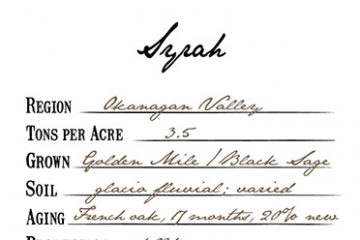The nose offers strawberries and oyster shells. More tart on the palate, it has strawberry-rhubarb with a chaser of cranberry. Oyster shells linger in the background throughout. A hint of lime lingers on the finish. Dry and very crisp, this would pair well with a lentil salad. Try this lentil
The emergence of syrah in Canada, and in particular in British Columbia's Okanagan Valley, has been one of the most pleasant developments of the last few years, in Canada, and this wine is one of the finest examples of what that grape can do in that particular region. Born of
In 2010, the Chinese takeover of the fine wine investment market was big news. Premium Bordeaux futures were selling like hot cakes, particularly off the back of the 2008 vintage (the Chinese symbol for the number 8 is considered to be very auspicious), and any fine wine merchant worth his
The nose smells like blackberries crushed over the crisp, smoky end of a good prime rib, with a bit of soy sauce in the background. Smokiness comes out on the palate, under juicy blackberries and crisp beef fat. Black pepper and soy show on the mid-palate. This has good minerality
The nose smells like blackberries crushed over the crisp, smoky end of a good prime rib, with a bit of soy sauce in the background. Smokiness comes out on the palate, under juicy blackberries and crisp beef fat. Black pepper and soy show on the mid-palate. This has good minerality
Color is starting to add some orange-hued brick around the edges. The first whiff on the nose makes it clear that this is more Rhone than Outback, showing blackberries, black olives, and very rare beef. Blackberries and olives show, too, on the palate, with tar, white pepper and a tiny
Pliny the Elder, the Roman author, was a fan of wines from the Rhône Valley. Something he wrote nearly 2,000 years ago struck winemaker Pierre Gaillard, a student of wine history, as a tip for finding something almost incredible today: unused Grand Cru-level terroir in the heart of French wine
Five clones of estate-grown syrah are blended together to produce a wine full of nice, tarry fruit. Balanced by good acidity, this wine is hearty from nose through palate to finish. Yet it has a touch of florals throughout as well, which add both a hint of delicacy and another


